- Home
- Pat Conroy
The Pat Conroy Cookbook Page 14
The Pat Conroy Cookbook Read online
Page 14
We chose Italy because of the weather and because Italians seemed as friendly as Southerners. My mother raised a grinning child with a congenital need to be around other smiling people. We rented a house outside Rome in a compound surrounding a castle called Largo Olgiata. We moved to ancient Rome to reside in a modern villa built in 1971. Our house was made up of rhomboids and trapezoids and had all the warmth of a Rubik’s cube. But the house was authentically Italian, and we did without electricity, gas, telephone, heat, and water at various unbearably lengthy intervals during our time there. If something worked in Italy, it was considered accidental and temporary, and rather amusing.
Instead of writing deathless, flowing prose, I spent much of my time apologizing to my children for brutally uprooting them from the emerald city, Atlanta, and transporting them to Europe. Moving will never be easy for children, and no child will ever make it easy on his or her parents. I showed them the Alps, castles, medieval towns, the Sistine Chapel, the mustard crops of Dijon, the lake country of Italy, and all the glories of the Uffizi Palace, and they fixed me with their wounded, kidnapped eyes and wailed they would much rather be at Six Flags Over Georgia. High in a snow-glistening Alpine pass I heard one of the children whisper, “This is okay, but I like Stone Mountain a lot better.”
But the South was deeply in them. The fall we lived in Rome, Lenore and I took the children to Florence as a reward for not once mentioning Atlanta during a blissful three-hour period. We stayed at the exquisite hotel Villa la Massa, in Bagno a Ripoli, a converted palazzo overlooking the Arno River. The Villa la Massa was my candidate for the perfect hotel, with a splendid restaurant, a discreet staff, grapes ripening in the arbors, and a German shepherd named Otto who was multilingual and could say “good morning” in four languages. There was a small chapel in the garden, a bar with gold-leaf wallpaper overlooking the river, and brimming fishponds. The goldfish, wary of the resident cats, swished along the bottom like animated bullion. A perfect hotel can seduce even children, and I watched each of them solemnly sign the leather-bound guest book in the hotel’s sitting room. When I signed the book as we left, I read my daughter’s note. She had loved the hotel but was holding fast to her identity. The note read: Megan Conroy Atlanta, Georgia. How ‘Bout Them Dawgs?
Yet education is a secret and indefinable thing, and I watched the effects of travel on my children, who changed, despite their allegiance to Atlanta. I had a feeling the sediments of Rome were going to rest in the hidden sills of their memories for years to come. While in Rome, they went to dinner with an Italian countess who had attended bullfights with Ernest Hemingway; drifted silently beside the tombs of popes; went to parties with their schoolmates, Soorig, Dariush, Atubia, and Jean-Franco; ate octopus (“It tastes like a tire, Dad”), prosciutto, finocchio (fennel), and a dozen different varieties of olives and olive oils; tasted wine from almost every district in Italy; sledded in the Apennines with a writer who had written five novels; and lit votive candles in every church along the Corso in Rome. (They prayed they would soon return to Atlanta.) I no longer told them that they’d someday regret not getting more out of the Roman years. Rome did its work quietly on all of us, and there was nothing we could do about it except be grateful.
My youngest daughter, Susannah Ansley, was born on December 7 at Salvator Mundi International Hospital in Rome. I became the first Southern writer I’ve ever known who’s the father of an Italian citizen. She was delivered by cesarean section in the city where Julius Caesar drew his first breath by the same method more than two thousand years ago. When Sister Magdolena emerged from the operating room she carried an inert bundle in her arms and passed me without saying a word or nodding in my direction. Her face was covered with a gauze mask and the baby, ominously silent, lay still beneath a white blanket that covered her face. I trailed after Sister Magdolena until she came to a small chapel. She entered, held the child aloft, and genuflected before a crucifix.
“Sister,” I asked, “I hate to bother you, but can I ask you a question?”
“Sì,” she answered through gauze.
“Is this my baby?”
“Sì.”
“Sister Magdolena, is the baby alive?”
“Sì. Big. Molto grande. Tre kilos, sette cento.”
“Can I see the baby?”
“No, signore. You have many germs in the mouth.”
I could have lived in Italy for a hundred years and never known the true weight of tre kilos, sette cento. Later, an American friend with a calculator informed me that Susannah weighed eight pounds, three ounces. I called my mother that night and told her that the family had produced another Roman. My mother was born in Rome, Georgia, and the binding of the two Romes provided a pure associative joy.
When she was old enough to understand, and we were back in the South, I told Susannah about Rome and her first days on earth and the friends who came to see her in the hospital. I told her why we went to Rome and how the city changed us forever. That is the singular gift of travel: it changes you because it gives you more to celebrate, to cherish, and to remember. I told Susannah how Italy changed me and changed how I looked at the world. It made me confront the essence of my being Southern. It had nothing to do with geography; it had everything to do with my own personal view of the world.
When I refer to myself as Southern, I am talking about the part of myself that is most deeply human and deeply feeling. It is the part of me that connects most intimately and cordially with the family of humankind. There are qualities of grace and friendship and courtesy that will always seem essentially Southern to me, no matter where I encounter them on the road. Then I told my daughter that I never appreciated the South until I left it for the first time. And that the reason you travel is to find out who you really are and what you really believe. I came to understand that the country of Italy produced Michelangelo, da Vinci, Dante, Garibaldi, and most significantly, for the history of my family, because of accident and writing and a need for definition, a pretty black-haired Roman named Susannah Ansley Conroy
ITALIAN SAUSAGE WITH CRISPY SWEET POTATOES AND WILTED BROCCOLI RABE • SERVES 4
3 large sweet potatoes (about 3 pounds), peeled and sliced into ¼-inch medallions
Olive oil
1 lemon, halved
Coarse or kosher salt and coarsely ground black pepper
3 pounds hot Italian sausage (in one piece)
Two 1½-pound bunches broccoli rabe, trimmed, washed, dried, and cut into 1-inch pieces
1. Preheat the oven to 400°F.
2. Toss the sweet potato slices with olive oil until lightly coated (do not drench). Add the juice of half a lemon and salt and pepper to taste. Divide and transfer to two baking pans. (Overcrowding will prevent the potatoes from browning.) Roast until golden brown, about 20 minutes, turning the slices over halfway through. Set aside.
3. Lower the oven temperature to 350°F.
4. Loosely coil the sausage into a large ovenproof skillet (packing it too tightly will prevent the sausage from cooking evenly). Prick the casing with a fork or the tip of a sharp paring knife (you want the sausage to provide cooking liquid for the broccoli rabe) and place the skillet in the oven until the sausage is cooked through, 20 to 25 minutes. Transfer the sausage to a cutting board and loosely cover with aluminum foil.
5. Return the potatoes to the oven.
6. Transfer the hot skillet (be careful; the handle will also be hot) to the top of the stove over moderate heat and bring the sausage cooking liquid to a low simmer. Immediately add the broccoli rabe (this must be done slowly because the skillet will be very full until the broccoli rabe begins to wilt), squeeze the remaining half a lemon over the greens, and cook until crisp-tender, about 3 minutes. Transfer to serving dishes.
7. Cut the sausage into serving-size pieces and place on top of the greens. Tuck the warm potato medallions alongside and serve immediately.
ROASTED FIGS WITH FRASCATI ZABAGLIONE When my daughter was born in Rome, Italy, on December 7,
1981, I sent telegrams to the United States to the houses of Bo Marks and Mike Devito. The telegrams said, “The first true Italian has been born to our room, and her name is Susannah Ansley Conroy” For one week, until I registered her with the questora, Susannah was an Italian citizen, and I rejoiced in that sweet fact. I was the first to father an Italian child in the history of the Conroy family, and all the surprises and astonishments and switchbacks of fate and history lay contained in the joy of her birth.
While living in Italy, I grew familiar with all the small-change bigotries that the Italians from different regions have for one another. When I told an elegant Milanese businessman that I lived in Rome he sneered and said, “Africa,” summing up the northern Italians’ contempt for those in the south. I remembered Bo-Pig and Mike-Swine warning me about the provenance of each other’s families when we roomed together at The Citadel.
Mike would mutter darkly about Bo, “You cannot trust Bo-Pig. He is Siciliano.”
“He’s what?” I’d ask.
“A Sicilian. They are the scum of Italy.”
“Wake up, boy. You’re an American now.”
“Some things never change,” Mike said. “Blood is blood.”
“Where are your people from?”
“Northern Italy. I came from aristocrats,” said Mike.
Later Bo-Pig would take me aside and say, “You can’t trust Mike, paisan.”
“Why not?”
“His family is from northern Italy.”
When I returned to America, Mike and I went out to Gene and Gabe’s Restaurant in Atlanta. We talked about my long-ago weekend in Greensburg and the pleasure of getting to know Phyllis Parise and her family.
“The reason you liked the Parise family so much is because they are from northern Italy like my family,” Mike said.
“Where in northern Italy are they from?” I asked.
“Naples,” said Mike with pride and could not understand why I roared with laughter. Naples, of course, is the very heart and soul of southern Italy. • SERVES 6
24 Black Mission figs
ZABAGLIONE SAUCE
6 egg yolks
½ cup sugar
Pinch of salt
1 cup Frascati wine
1 cup heavy cream
2 teaspoons freshly ground white pepper
1. Preheat the oven to 400°F.
2. Place the figs on a jelly roll pan or in a shallow cooking dish to maximize browning (do not crowd the figs because they will steam instead of roast).
3. Roast the figs until soft, 5 to 8 minutes. Remove the pan to a rack and cool to room temperature.
4. To make the sauce: Fill a heatproof bowl (large enough to hold the bowl with the zabaglione) with ice and reserve.
5. Simmer water in the bottom of a double boiler.
6. Place the egg yolks in a stainless steel mixing bowl and whisk in the sugar, salt, and Frascati. Suspend the egg mixture bowl over the simmering water (the bowl should not touch the water) and whisk rapidly (to incorporate as much air as possible) until the egg mixture is thick and pale yellow, 8 to 10 minutes. (The mixture should not boil.)
7. Nestle the zabaglione bowl into the bowl filled with ice and continue whisking until the zabaglione is cold.
8. Whip the cream and fold it into the zabaglione. This can now be refrigerated until ready to serve.
9. When the figs are room temperature, transfer them to large balloon-shaped wineglasses, 4 per glass. Fold the white pepper into the zabaglione and spoon the sauce over the figs to serve.
SQUASH BLOSSOMS THREE WAYS When I was living in Rome, the Jewish ghetto was very near our house on Via dei Foraggi. The restaurants of the ghetto, like all of the other restaurants in the city, were wonderful, but their specialties of stuffed fried zucchini blossoms and fried artichokes were both ambrosial. In the first summer Suzanne Pollak and I were planning this cookbook (that was ten years ago—Suzanne’s a quick study, but she soon found that her partner moved like a glacier through the high mountain passes), Suzanne discovered a farmer who brought her twenty zucchini blossoms he had picked from his garden that morning. Since I am a devotee of the great Italian cookbook writer Marcella Hazan, I knew that the male blossoms were the only ones good enough to eat. The male blossoms grow on stems, while the female blossoms are attached to the zucchini and are too mealy for Marcella’s refined palate.
All afternoon, Suzanne and I thought up new stuffings for zucchini blossoms, then fried them in peanut oil. The three recipes that follow were the best we came up with. Incidentally, in her masterful book Essentials of Classic Italian Cooking, Marcella dips the blossoms in a pastella, a flour and water batter, then fries them without stuffing. In the ghetto of Rome, they stuff them with magnificent and tasty ingredients. Like all glorious fried things, they should be eaten while hot to the touch.
Fried Squash Blossoms • SERVES 6 AS AN APPETIZER
12 open squash or zucchini blossoms
⅔ cup all-purpose flour
¼ teaspoon sweet smoked paprika
Peanut oil
Sea salt
1. Line a baking sheet with brown paper bags and set aside.
2. Rinse the blossoms, gently checking to make sure there are no bugs inside.
4. Pour 1 cup cold water in a pie pan or shallow bowl. Sift the flour and paprika into the pan, whisking constantly to prevent any lumps.
4. Add enough oil to a heavy frying pan to come about ¾ inch up the sides of the pan. Heat the oil over medium-high heat until almost smoking. Working with one at a time, use tongs to dip each blossom in the batter, letting the excess drip back into the pan. Slip 2 or 3 batter-covered blossoms (as many as will comfortably fit in the frying pan) in the hot oil and cook until golden brown, turning only once, about 2 minutes total.
5. Transfer the fried blossoms to the prepared baking sheet to drain. Sprinkle with salt and serve piping hot.
Stuffed Squash Blossoms 1 • SERVES 6 AS AN APPETIZER
12 open squash or zucchini blossoms
⅔ cup all-purpose flour
¼ teaspoon sweet smoked paprika
12 small pieces (about ⅛ pound) Manchego cheese, about ¼ inch thick and 1 inch long
2 thin slices Serrano ham, cut into 12 pieces
Peanut oil
Sea salt
1. Line a baking sheet with brown paper bags and set aside.
2. Rinse the blossoms, gently checking to make sure there are no bugs inside.
3. Pour 1 cup cold water in a pie pan or shallow bowl. Sift the flour and paprika into the pan, whisking constantly to prevent any lumps. Set aside.
4. Insert a piece of cheese and a piece of ham into each open blossom. Carefully twist the ends of the blossoms to close them.
5. Add enough oil to a heavy frying pan to come about ¾ inch up the side of the pan. Heat the oil over medium-high heat until almost smoking. Working with one at a time, use tongs to dip each blossom in the batter, letting the excess drip back into the pan. Slip 2 or 3 blossoms (as many as will comfortably fit in the frying pan) in the hot oil and fry, turning once, until the blossoms are golden brown and the cheese is melted, 2 to 3 minutes.
6. Transfer the fried blossoms to the paper bags to drain. Sprinkle with sea salt and serve.
Stuffed Squash Blossoms 2 • SERVES 6 AS AN APPETIZER
12 open squash or zucchini blossoms
⅔ cup all-purpose flour
¼ teaspoon sweet smoked paprika
12 small pieces (about ⅛ pound) fresh mozzarella, about ¼ inch thick and 1 inch long
12 Sicilian (green) olives, pitted and quartered
Peanut oil
Sea salt
1. Line a baking sheet with clean brown paper bags and set aside.
2. Rinse the blossoms, gently checking to make sure there are no bugs inside.
3. Pour 1 cup cold water in a pie pan or shallow bowl. Sift the flour and paprika into the pan, whisking constantly to prevent any lumps. Set aside.
4. Insert a piec
e of cheese and 4 olive quarters into each open blossom. Carefully twist the ends of the blossoms to close them.
5. Add enough oil to a heavy frying pan to come about ¾ inch up the sides of the pan. Heat the oil over medium-high heat until almost smoking. Working with one at a time, use tongs to dip each blossom in the batter, letting the excess drip back into the pan. Slip 2 or 3 blossoms (as many as will comfortably fit in the frying pan) in the hot oil and fry, turning once, until blossoms are golden brown and cheese is melted, 2 to 3 minutes.
6. Transfer the fried blossoms to the paper bags to drain. Sprinkle with sea salt and serve.
SALTIMBOCCA ALLA ROMANA If you are a beginning cook, Saltimbocca alla Romana is a dish you should incorporate into your repertoire immediately. It is simple, easy to prepare, and magnificent. In Italian, saltimbocca means “to jump in the mouth,” a fond acknowledgment of its wonderful taste. • SERVES 4
Eight 3- to 4-ounce veal scallops

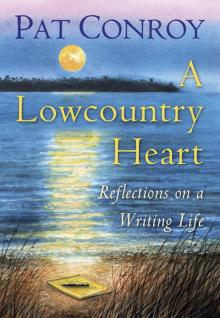 A Lowcountry Heart: Reflections on a Writing Life
A Lowcountry Heart: Reflections on a Writing Life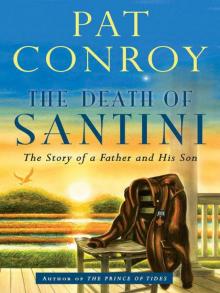 The Death of Santini: The Story of a Father and His Son
The Death of Santini: The Story of a Father and His Son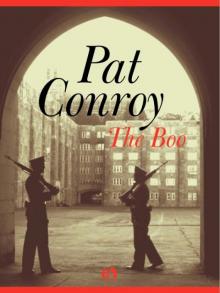 The Boo
The Boo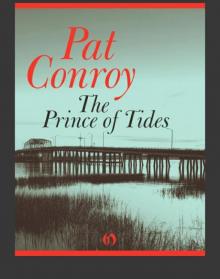 The Prince of Tides
The Prince of Tides Beach Music
Beach Music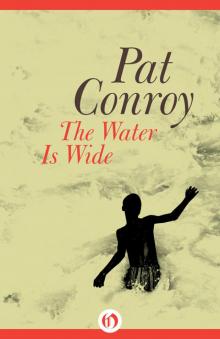 The Water Is Wide
The Water Is Wide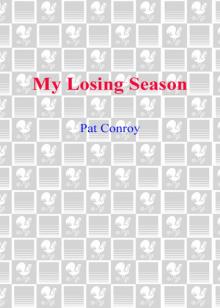 My Losing Season
My Losing Season The Lords of Discipline
The Lords of Discipline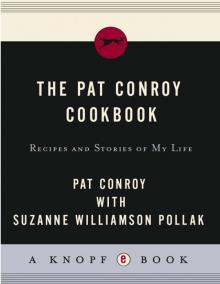 Pat Conroy Cookbook
Pat Conroy Cookbook My Reading Life
My Reading Life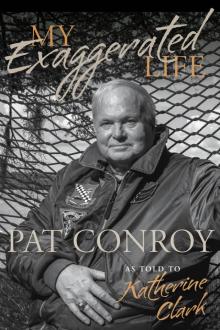 My Exaggerated Life
My Exaggerated Life The Pat Conroy Cookbook
The Pat Conroy Cookbook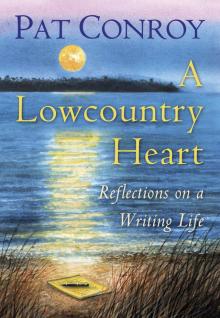 A Lowcountry Heart
A Lowcountry Heart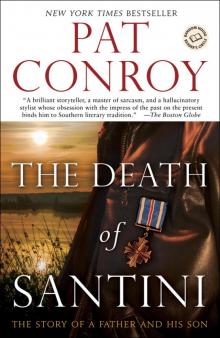 The Death of Santini
The Death of Santini